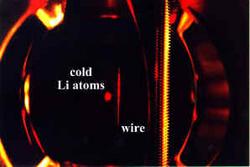Atoms Probe an Unnatural Force Field

One of the oldest problems in physics is predicting the motion of objects influenced by gravity–cannon balls, planets, or satellites–and then verifying the predictions. The force of gravity varies as the inverse square of the distance between the objects, but how would Earth’s orbit look if the Sun’s attraction depended on the inverse third power of distance? That question is answered theoretically in a typical college physics course, but in the 27 July PRL an Austrian team reports the first observation of objects moving under the influence of such a force. They show that cold atoms fall toward a thin, charged wire in the predicted manner and suggest that using small material objects to influence atomic motions, rather than using lasers, could allow for new types of atomic physics experiments.
Although a charged particle at a distance r experiences a force from a point charge, or a force from an infinitely long line of charge, a neutral atom feels a tug proportional to from a line charge. (The line’s electric field polarizes the atom, moving its electron cloud slightly off center and allowing it to feel the force, even though it remains neutral overall.) For a force there are no stable orbits: If the Sun’s gravity worked that way, planets could only spiral inward. An incoming comet with enough energy could make one loop around the Sun and fly off in another direction forever.
Jörg Schmiedmayer and his colleagues at the University of Innsbruck hope to study the quantum effects of confining atoms in small spaces. They want to use force fields created by charges and electric currents in small material objects because these may be better suited to the task than are laser beams. As their first step in that direction, the team observed atoms interacting with charged wires as small as a micrometer in diameter–a good approximation to the textbook scenario of an infinitely long and thin line of charge.
They began by cooling a cloud of lithium atoms using a standard magneto-optic trap, combining a magnetic field with laser beams to confine about 10 million atoms to a cloud 1 mm across. They then guided the cloud to the charged wire and drastically reduced the laser power, so that the atoms could move freely, influenced only by the wire’s force field, or “potential.” At this point, the cloud survived for only a second or two. The dim laser light revealed that the atoms disappeared from the cloud at a rate dependent upon the wire’s thickness and charge, in good agreement with the team’s theory. Because of the force, the atoms either spiraled into the wire, where they were absorbed, or they entered orbits that sent them out of the wire’s neighborhood.
The arrangement was novel because atoms are normally maintained in some kind of confining “potential well,” with lasers, but in this case the potential had a singularity at the center. Schmiedmayer and his colleagues believe the fields created around small material objects can be used to design a range of new potential shapes for a variety of atomic physics experiments.
“I am very excited by the prospect of bringing cold atoms near surfaces,” says Edward Hinds, of Sussex University, in Brighton, England. He believes it may allow an integration of conventional optoelectronics with “atom optics,” the manipulation of atomic beams as waves, somewhat like laser beams. “Schmiedmayer’s experiment is a small step in that very appealing direction,” he says. Schmiedmayer foresees replacing the wire and performing even more exotic experiments: “My dream is to have a nanotube or a DNA molecule in there.”


